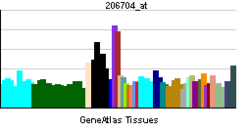CLCN5
| View/Edit Human | View/Edit Mouse |
H(+)/Cl(-) exchange transporter 5 is a protein that in humans is encoded by the CLCN5 gene.[3][4]
This gene encodes a member of the ClC family of chloride ion channels and ion transporters. Mutations in this gene have been found in Dent's Disease and renal tubular disorders complicated by nephrolithiasis.[5] Although a member of a family of chloride channels, the CLCN5 protein allows movement of protons in the opposite direction of Cl(-), thus functioning as an antiporter.[6]
See also
References
- ↑ "Human PubMed Reference:".
- ↑ "Mouse PubMed Reference:".
- ↑ Fisher SE, Black GC, Lloyd SE, Hatchwell E, Wrong O, Thakker RV, Craig IW (Apr 1995). "Isolation and partial characterization of a chloride channel gene which is expressed in kidney and is a candidate for Dent's disease (an X-linked hereditary nephrolithiasis)". Hum Mol Genet. 3 (11): 2053–9. PMID 7874126.
- ↑ Pook MA, Wrong O, Wooding C, Norden AG, Feest TG, Thakker RV (Mar 1994). "Dent's disease, a renal Fanconi syndrome with nephrocalcinosis and kidney stones, is associated with a microdeletion involving DXS255 and maps to Xp11.22". Hum Mol Genet. 2 (12): 2129–34. doi:10.1093/hmg/2.12.2129. PMID 8111383.
- ↑ "Entrez Gene: CLCN5 chloride channel 5 (nephrolithiasis 2, X-linked, Dent disease)".
- ↑ Picollo A, Pusch M (2005). "Chloride/proton antiporter activity of mammalian CLC proteins ClC-4 and ClC-5.". Nature. 436 (7049): 420–3. doi:10.1038/nature03720. PMID 16034421.
Further reading
- Igarashi T, Hayakawa H, Shiraga H, et al. (1995). "Hypercalciuria and nephrocalcinosis in patients with idiopathic low-molecular-weight proteinuria in Japan: is the disease identical to Dent's disease in United Kingdom?". Nephron. 69 (3): 242–7. doi:10.1159/000188464. PMID 7753256.
- Scheinman SJ, Pook MA, Wooding C, et al. (1993). "Mapping the gene causing X-linked recessive nephrolithiasis to Xp11.22 by linkage studies.". J. Clin. Invest. 91 (6): 2351–7. doi:10.1172/JCI116467. PMC 443292
 . PMID 8099916.
. PMID 8099916. - Lloyd SE, Pearce SH, Fisher SE, et al. (1996). "A common molecular basis for three inherited kidney stone diseases.". Nature. 379 (6564): 445–9. doi:10.1038/379445a0. PMID 8559248.
- Fisher SE, van Bakel I, Lloyd SE, et al. (1996). "Cloning and characterization of CLCN5, the human kidney chloride channel gene implicated in Dent disease (an X-linked hereditary nephrolithiasis).". Genomics. 29 (3): 598–606. doi:10.1006/geno.1995.9960. PMID 8575751.
- Lloyd SE, Pearce SH, Günther W, et al. (1997). "Idiopathic low molecular weight proteinuria associated with hypercalciuric nephrocalcinosis in Japanese children is due to mutations of the renal chloride channel (CLCN5).". J. Clin. Invest. 99 (5): 967–74. doi:10.1172/JCI119262. PMC 507905
 . PMID 9062355.
. PMID 9062355. - Pirozzi G, McConnell SJ, Uveges AJ, et al. (1997). "Identification of novel human WW domain-containing proteins by cloning of ligand targets.". J. Biol. Chem. 272 (23): 14611–6. doi:10.1074/jbc.272.23.14611. PMID 9169421.
- Oudet C, Martin-Coignard D, Pannetier S, et al. (1997). "A second family with XLRH displays the mutation S244L in the CLCN5 gene.". Hum. Genet. 99 (6): 781–4. doi:10.1007/s004390050448. PMID 9187673.
- Lloyd SE, Gunther W, Pearce SH, et al. (1997). "Characterisation of renal chloride channel, CLCN5, mutations in hypercalciuric nephrolithiasis (kidney stones) disorders.". Hum. Mol. Genet. 6 (8): 1233–9. doi:10.1093/hmg/6.8.1233. PMID 9259268.
- Schurman SJ, Norden AG, Scheinman SJ (1998). "X-linked recessive nephrolithiasis: presentation and diagnosis in children.". J. Pediatr. 132 (5): 859–62. doi:10.1016/S0022-3476(98)70318-X. PMID 9602200.
- Günther W, Lüchow A, Cluzeaud F, et al. (1998). "ClC-5, the chloride channel mutated in Dent's disease, colocalizes with the proton pump in endocytotically active kidney cells.". Proc. Natl. Acad. Sci. U.S.A. 95 (14): 8075–80. doi:10.1073/pnas.95.14.8075. PMC 20931
 . PMID 9653142.
. PMID 9653142. - Devuyst O, Christie PT, Courtoy PJ, et al. (1999). "Intra-renal and subcellular distribution of the human chloride channel, CLC-5, reveals a pathophysiological basis for Dent's disease.". Hum. Mol. Genet. 8 (2): 247–57. doi:10.1093/hmg/8.2.247. PMID 9931332.
- Lamb FS, Clayton GH, Liu BX, et al. (1999). "Expression of CLCN voltage-gated chloride channel genes in human blood vessels.". J. Mol. Cell. Cardiol. 31 (3): 657–66. doi:10.1006/jmcc.1998.0901. PMID 10198195.
- Strausberg RL, Feingold EA, Grouse LH, et al. (2003). "Generation and initial analysis of more than 15,000 full-length human and mouse cDNA sequences.". Proc. Natl. Acad. Sci. U.S.A. 99 (26): 16899–903. doi:10.1073/pnas.242603899. PMC 139241
 . PMID 12477932.
. PMID 12477932. - Moulin P, Igarashi T, Van der Smissen P, et al. (2003). "Altered polarity and expression of H+-ATPase without ultrastructural changes in kidneys of Dent's disease patients.". Kidney Int. 63 (4): 1285–95. doi:10.1046/j.1523-1755.2003.00851.x. PMID 12631345.
- Wu F, Roche P, Christie PT, et al. (2003). "Modeling study of human renal chloride channel (hCLC-5) mutations suggests a structural-functional relationship.". Kidney Int. 63 (4): 1426–32. doi:10.1046/j.1523-1755.2003.00859.x. PMID 12631358.
- Carballo-Trujillo I, Garcia-Nieto V, Moya-Angeler FJ, et al. (2003). "Novel truncating mutations in the ClC-5 chloride channel gene in patients with Dent's disease.". Nephrol. Dial. Transplant. 18 (4): 717–23. doi:10.1093/ndt/gfg016. PMID 12637640.
- Ludwig M, Waldegger S, Nuutinen M, et al. (2004). "Four additional CLCN5 exons encode a widely expressed novel long CLC-5 isoform but fail to explain Dent's phenotype in patients without mutations in the short variant.". Kidney Blood Press. Res. 26 (3): 176–84. doi:10.1159/000071883. PMID 12886045.
- Hryciw DH, Wang Y, Devuyst O, et al. (2003). "Cofilin interacts with ClC-5 and regulates albumin uptake in proximal tubule cell lines.". J. Biol. Chem. 278 (41): 40169–76. doi:10.1074/jbc.M307890200. PMID 12904289.
External links
- CLCN5 protein, human at the US National Library of Medicine Medical Subject Headings (MeSH)
This article incorporates text from the United States National Library of Medicine, which is in the public domain.
This article is issued from Wikipedia - version of the 5/22/2016. The text is available under the Creative Commons Attribution/Share Alike but additional terms may apply for the media files.



